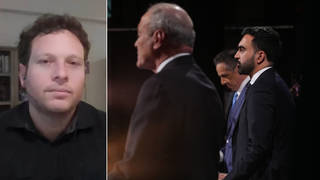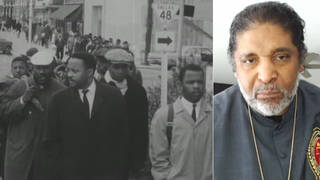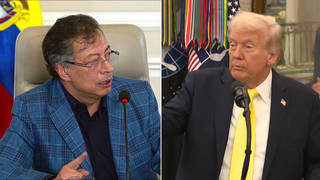
Topics
Guests
- Kike ArnalVenezuelan photographer and documentary filmmaker. His book is 'In the Shadow of Power'
- Ralph Naderlongtime consumer advocate. He wrote the introduction to 'In the Shadow of Power'
Washington, DC is the most powerful capital city in the world. But it’s also a city that is deeply divided between a wealthy and extremely influential minority and an impoverished and largely disenfranchised African American majority. The seat of global power is also home to a population that remains largely invisible to the politicians, journalists, lawyers, lobbyists and contractors around Capitol Hill. This other Washington, DC maintains the dubious distinction of having the highest rate of child poverty, the highest mortality rate from HIV/AIDS, and the lowest life expectancy in the country. Kike Arnal discusses his new book of photography, In the Shadow of Power. [includes rush transcript]
Transcript
AMY GOODMAN: Ralph, I want to turn now to a book that you have written in the introduction to. Washington, DC is the most powerful capital city in the world, but it’s also a city that’s deeply divided between a wealthy and extremely influential minority and an impoverished and largely disenfranchised African American majority. The seat of global power is also home to a population that remains largely invisible to the politicians, the journalists, the lawyers, lobbyists and contractors around Capitol Hill. This other Washington, DC maintains the dubious distinction of having the highest rate of child poverty, the highest mortality rate from HIV/AIDS, and the lowest life expectancy in the country.
Ralph Nader, you wrote the introduction to this new book of black-and-white photographs documenting some of the haunting contrasts that mark our nation’s capital. The photographer Kike Arnal is from Venezuela, and the book is called In the Shadow of Power. Ralph, you really have felt that this book captures the place you live in, Washington, DC, that is our nation’s capital. Why is it so important to you?
RALPH NADER: Well, it represents the class structure in this country, to a very severe point. Washington, DC is home to about almost 600,000 people. About 54 percent of the people in Washington are African Americans. Northwest Washington is quite prosperous. It’s where the government buildings are, where the well-to-do live. And the rest of Washington — southeast, northeast, southwest — largely quite poor.
And that’s almost an understatement in some of the areas. They look like they’re bombed out. They’re desolate. Homelessness, hunger, the highest AIDS prevalence in the United States, high infant mortality. The schools are now in the process of being repaired, but they were in terrible shape for many years. The neighborhood libraries are still in bad shape. Public facilities are degraded.
And at the same time that the people of Washington, DC do not have the vote to elect members of Congress. They’re the only Western capital in the entire world that has been disenfranchised. And President Obama, when he was a candidate, and the Democratic Party, said, “Well, when we take control of Washington, we’ll fix that right away and give the District of Columbia one — at least one voting representative in the House.” That has not even been taken off the table.
So this new book by Kike Arnal, In the Shadow of Power — and the website to obtain it is intheshadowofpower.com — this new book is really a haunting black-and-white collection of photographs that Kike put together after walking the streets of Washington, DC, day after day, all over the city. He jokes that if he doesn’t remain a photographer, he could be licensed as a cabdriver. And we’re releasing it this week, so that not just people in Washington, but people around the country and around the world, can see that the capital of the Western world has been allowed to continue a deterioration process that is a scar on the conscience of our country.
AMY GOODMAN: Well, we are also joined by Kike Arnal himself, the Venezuelan photographer, documentary filmmaker. His book, In the Shadow of Power.
Kike, talk about your journey in Washington, DC. You got the idea for this when you were hired to photograph the deteriorating libraries of Washington, DC?
KIKE ARNAL: Yeah. In 2000, I was hired to photograph the public library system of Washington. And driving to the different branches of the public library — there were twenty-seven branches at the moment — I had to cross to the other side of the Anacostia River, and I discovered a totally different city that I wasn’t expecting to see. The Washington I knew was in the Washington of the beautiful monuments, the Mall, the Capitol Hill, the White House. And then I discovered this other Washington, and it reminded me a lot of the slums and of the poor neighborhoods in South America where I come from, in Venezuela or Brazil, Colombia.
AMY GOODMAN: Talk about your photographs. What is the one for you that captures most what you see when you walk around Washington, DC?
KIKE ARNAL: Well, there are a few images that I think epitomize the content of the book. Maybe the cover is a very particular one, this guy seated at the exit of the subway station at McPherson Street only a couple of blocks from the White House. And it really is really surprising to see this kind of situation happening so close to the seat of power.
Also, I spent time photographing at a hospice for people dying of HIV, and it was — some of the most striking images I produced were taken there. It was interesting to discover that if it wasn’t for these social workers for this not-for-profit organization, these people would die right on the streets.
So the whole process of photographing Washington, it took me about 250 days spread over a period of three years. It was a process of discovery of another, a different city. And it was a very dramatic experience.
AMY GOODMAN: What about the man looking through the window? Describe that, especially for our listeners now who listen on the radio.
KIKE ARNAL: Yeah, I guess some of you — for those who can’t see the photograph that are listening on the radio, please go to our website. It’s intheshadowofpower.com. And there you can see the photograph, and you will know about the events we are organizing to promote the book and to promote the work.
But that particular image, I was waiting for someone, to meet with someone at a coffee shop in downtown Washington. And all of the sudden I see this homeless guy coming to the window, looking inside of the coffee shop. And everybody were just immersed on their lecture, not even pretending to see, to notice this person. That image is also — actually, I think it’s one of the most powerful photographs of the book, and it also epitomizes the content of the work, of the book.
AMY GOODMAN: We’re talking to Kike Arnal, the Venezuelan photographer and documentary filmmaker who published this book, In the Shadow of Power. Compare it to what you see in Venezuela.
KIKE ARNAL: Well, Venezuela, we have immense social inequalities in our country. And unfortunately, this is [inaudible]. It’s a very difficult situation to overcome. I don’t think any of the governments that we had in the last thirty, forty years have been able to solve these issues. But I wasn’t expecting to find this level of poverty in the capital. I really — I was really surprised to see poverty and racial segregation of levels that I — you could only see in third world countries.
AMY GOODMAN: Well, Kike Arnal, I want to thank you very much for being with us, a photographer, documentary filmmaker. You can go to his website, intheshadowofpower.com. Also on our broadcast today, democracynow.org, you can see some of those photos. And Ralph Nader, thank you very much for being with us. Final words, from In the Shadow of Power to what we’re seeing right now on Capitol Hill?
RALPH NADER: Yes. I think what we have to do is — what no one can stop us from doing is picking up those phones and/or otherwise contacting your senators and saying, “Look, there’s going to be heck to pay in the election if you don’t pass a strong financial consumer legislation.” Nobody can stop people from doing that. And I’ll tell you, when the senators get a few hundred calls in one day, they really freak out, from what they’ve been doing.
For people who are worried about sudden acceleration in their cars, there’s a toll-free number for NHTSA. It’s (888) 327-4236, (888) 327-4236. It’s only consumer complaints about the Toyota problem that galvanized both the media and the Department of Transportation into waking up and protecting the people on the highways. So keep those complaints coming, (888) 327-4236.
AMY GOODMAN: Ralph Nader, we’re going to leave it there. Thank you very much for being with us, longtime consumer advocate, many time presidential candidate.
RALPH NADER: Thank you.












Media Options